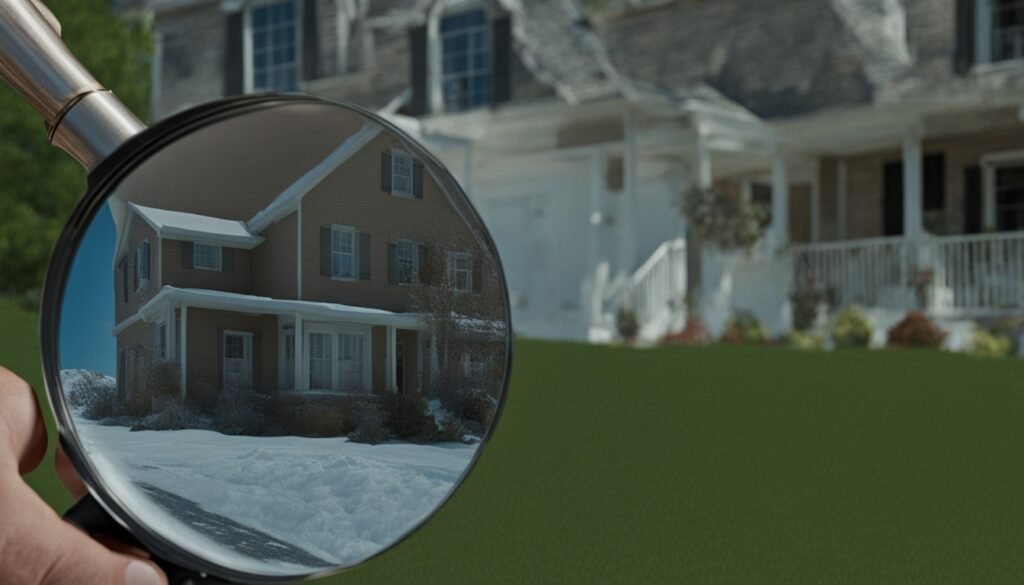A clear understanding of what is an adverse condition in real estate is key to smart decisions in buying and selling property. These conditions include factors that make properties less desirable or less valuable. With over 200 identified issues, it’s crucial for buyers and sellers to know about them.
Not knowing or hiding these issues can lead to big problems and legal trouble. Knowing about adverse conditions helps in evaluating properties. It also helps in negotiating and managing risks.
Key Takeaways
- Over 200 detrimental conditions can affect real estate values significantly.
- Remediation costs for adverse conditions may exceed original estimates.
- Failure to disclose adverse conditions is a leading cause of lawsuits in real estate.
- Market resistance can result in increased financing costs.
- Comparative analysis can help determine the impact of conditions on property value.
Understanding Adverse Conditions in Real Estate
Adverse conditions in real estate include many issues that can lower property value and make it less desirable. It’s important for buyers and sellers to know what these conditions are. They can be physical, environmental, or legal problems.
Physical issues like structural problems, water damage, or pests can lower property value and pose safety risks. Environmental factors, such as contamination near hazardous sites, can harm health and lower property prices. Legal issues, like title disputes and zoning problems, can make real estate deals more complicated.
Knowing about these adverse conditions is key. It helps set realistic expectations during negotiations and prepares for potential problems. By fixing these issues, property owners can make their investments more attractive to buyers.
For buyers and sellers, the effects are big. Buyers need to know that adverse conditions can affect financing and insurance costs. Sellers should understand that ignoring these issues can reduce interest and lower offers. Taking action on adverse conditions can greatly improve real estate deals.
| Condition Type | Examples | Implications |
|---|---|---|
| Physical | Structural damage, mold | Decreased value, safety risks |
| Environmental | Contaminated soil, noise pollution | Health issues, lower appeal |
| Legal | Title issues, zoning violations | Complicated transactions, ownership disputes |

What is an Adverse Condition in Real Estate?
An adverse condition in real estate means something that lowers the value or appeal of a property. It’s important to know what these conditions are and how they work. This knowledge helps buyers and sellers make better choices.
By looking at property defects and their causes, people can see how these issues affect their decisions. This is key in the world of real estate.
Definition and Examples
Adverse conditions come from many things, including:
- Structural defects that weaken the property.
- Environmental hazards, like flood zones or polluted land.
- Location-based issues, such as being close to noisy places, like highways or railroads.
Knowing about these conditions helps buyers understand the risks before they buy a property.
Impact on Property Value
Properties with adverse conditions can lose a lot of value. For example, homes near busy streets might lose $50,000 to $100,000 in value. These issues make it harder to figure out a property’s true worth.
Appraisers must consider these factors when they value a property. This makes the process more complex.
Types of Adverse Conditions
In real estate, many factors can lower property value and make living conditions less desirable. It’s important for buyers and sellers to know about these issues. Understanding what affects property value helps with making smart choices in real estate deals.
External Influences
Things outside a property can greatly affect its value. Busy roads, nearby commercial areas, and public transportation are examples. These can make a property less appealing, lowering its value. People looking to buy or sell property need to think about these factors.
Material Issues and Defects in Property
Material defects can be both visible and hidden, affecting how safe and useful a property is. Some examples include:
- Foundation cracks
- Water intrusion
- Electrical issues
- Structural damage
These issues can be costly to fix, making buyers more cautious. It’s key for buyers to know about these problems before buying.
Identifying Red Flags in Property Transactions
Spotting issues in property deals can save you from big mistakes. Look beyond what’s obvious. Sellers might list their properties for prices that seem too low or too high, hinting at hidden problems. Cosmetic changes like new paint or carpet might cover up serious defects. It’s key to inspect thoroughly to see what’s real.
Signs of Potential Problems
Some signs in real estate warn of deeper issues. Watch out for:
- Unusually low property prices: This could mean sellers are hiding something.
- Inconsistent communication: Agents who don’t respond well might not be trustworthy.
- Unaddressed material defects: Problems with plumbing, electrical, or structure can be big deals breakers.
- Limited disclosure: Not sharing important info about the property’s past can be a red flag.
Common Deal Breakers
Some issues can kill a deal fast. Don’t ignore these big turn-offs:
- Adverse neighborhood conditions: Properties in bad areas might scare off buyers.
- Hidden financial issues: Properties linked to money laundering or suspicious transactions can have hidden costs.
- Lack of a reliable agent: An inexperienced agent can mess up your deal.
- Cash transactions without proper documentation: This could mean laundering risks, especially in big deals.
The Importance of Property Disclosures
Property disclosures are key in real estate deals. Sellers have to tell buyers about any problems with the property. This part talks about the legal rules for real estate, especially about sharing bad news and what sellers and buyers should know.
Legal Obligations for Sellers
Sellers must follow the law by sharing bad news about the property. These issues can change a buyer’s mind and affect the property’s value. Things to check include:
- Termite infestations
- Structural damages such as cracked foundations
- Roof leaks
- Sewage problems
- Inaccuracies in property size
If sellers don’t share these details, they could face lawsuits. In Wisconsin, agents must tell buyers about big problems that might change their minds or stop them from buying. Being open helps sellers avoid trouble and helps buyers make smart choices.
What Buyers Should Look For
Buyers should carefully check property disclosures for any clues about the property’s condition. Important information should show up about defects or past problems. Focus on:
- Checking maintenance records
- Looking into neighborhood issues that could lower the value
- Asking about repair, renovation, or restoration history
This careful checking helps buyers make faster and smarter choices. It’s important for buyers to ask about anything unclear on the Seller’s Property Disclosure (SPD) form. This form is key to protecting buyers. When sellers are honest about the property, it builds trust and lowers the chance of future problems.

The Role of Property Inspection in Detecting Adverse Conditions
A thorough property inspection is key to finding hidden problems. It gives buyers important info about a property’s condition. Inspectors check every part of the house to spot issues that could lower its value or safety.
What to Expect During a Home Inspection
Buyers can look forward to a detailed check-up during an inspection. The aim is to find major flaws that could change the property’s value. Inspectors use strict standards to make sure their check is complete but not too deep. They look for things like roof problems, leaks, and electrical issues but don’t go deeper.
- Inspectors do not research code compliance or prior reports.
- They provide a snapshot of the property as it stands, without speculating on future conditions.
- While defects may be identified, latent defects may remain hidden, making follow-up evaluations essential.
Common Findings and Their Implications
Common issues found during inspections can greatly affect negotiations or future upkeep. Some big problems include:
| Issue | Implication |
|---|---|
| Roofing problems | Potential costly repairs and reduced market value |
| Plumbing leaks | Risk of water damage and increased insurance costs |
| Electrical concerns | Safety hazards and potential code violations |
Fixing these problems early lets buyers make smart choices, like negotiating for repairs or adjusting the price. Knowing what an inspection finds is key to a good deal.
Due Diligence for Home Buyers
The due diligence process is key in real estate deals, especially for home buyers. Getting ready before making an offer can greatly affect the success of the purchase. It includes many research steps to find potential problems and understand the property’s value.
Steps to Take Before Making an Offer
Before making an offer, buyers should follow several important steps during the due diligence period. This period usually lasts from 10 to 21 days. It allows for various evaluations to help make a well-informed decision. Key actions include:
- Conducting a home inspection to uncover any structural issues.
- Performing environmental inspections to assess potential hazards.
- Completing title searches and confirming land surveys for clear ownership.
- Verifying zoning compliance to ensure alignment with local regulations.
- Reviewing property tax records and homeowners association documents for history and fees.
Researching Property History and Neighborhood Factors
Understanding the property’s history is crucial for knowing past ownership, any issues, and changes in value. Looking into the neighborhood is also key; it helps understand the area’s demographics, crime rates, and amenities. Important things to consider include:
- Checking registered sex offenders and crime statistics in the area.
- Examining prior issues such as flooding or neighborhood decline.
- Evaluating potential zoning changes that could affect property use.
- Investigating community features like schools, parks, and transportation options.
By doing a thorough pre-purchase check, buyers can make better decisions. They can negotiate well, making sure their investment meets their goals.
| Due Diligence Activity | Description | Importance |
|---|---|---|
| Home Inspection | Assess structural integrity and identify repairs needed. | Uncovers potential major issues that could affect value. |
| Environmental Inspection | Evaluate the presence of hazardous materials and conditions. | Protects against health risks post-purchase. |
| Property History Check | Review past ownership and any adverse conditions. | Provides insight into property value trends. |
| Neighborhood Analysis | Investigate local demographics, crime rates, and amenities. | Helps assess the impact of location on value. |
Expert Insights on Appraisals with Adverse Conditions
It’s key to know how bad conditions affect property values for appraisers and buyers. The appraisal process changes a lot because of things like environmental dangers, neighborhood problems, and market trends. Spotting these issues makes sure appraisals are more accurate and increases transparency.
How Appraisals are Affected
Bad conditions can really change how appraisals turn out. Properties in areas with lots of crime or poor schools usually get lower appraised values. Homes near loud noises, like highways, also get appraised for less because of the noise.
Too many short-term rentals can lower values by up to 15%. Being close to health risks, like fracking sites, can drop values by 24%. Nearby distressed properties can also lower the market value. Outdated designs and not looking good from the outside can also lower appraisals.
Appraiser’s Responsibility to Disclose
Appraisers have to tell the truth and be clear about bad influences they find. They must share things like pest problems or structural issues. This helps everyone know the real value of the property.
The 2020-2021 Uniform Standards of Professional Appraisal Practice (USPAP) guide appraisers. They have to deal with tough conditions and make smart guesses. Following these rules helps appraisers be trusted and protect everyone’s interests in real estate.
Understanding the Impact of External Obsolescence
External obsolescence greatly affects property values. It comes from things like roads, commercial areas, and zoning changes. These external obsolescence factors make properties less desirable. It’s key for buyers and investors to know these risks when buying property.
How External Factors Affect Value
Properties near busy roads often lose value because of noise and traffic. Homes close to commercial buildings also see their value drop. This is because they’re not in a typical residential area.
Being near landfills or industrial sites can also lower property value. These places have bad smells and noise. High-voltage power lines add to the problems, showing how external factors affect property value.
Case Studies of Adverse External Influences
Looking at case studies in real estate values shows how external issues can lower property prices. Homes near foreclosures sell for less and stay on the market longer. This shows how community issues affect property value.
Properties near low-income areas can also lose value. This is because of the area’s economic state. Knowing these environmental damage effects helps in making smart real estate choices.
Conclusion
Understanding property transactions is key for buyers and sellers. Knowing how things like structural issues and outside factors affect real estate helps people move through the market better. It’s important to be careful and look out for signs that could lower a property’s value.
When it comes to real estate, being open about problems like high radon levels or leaning walls is crucial. This helps avoid future issues. Also, those in the real estate business must tell everyone about any big problems they know of. This makes sure deals are honest and fair.
Knowing about potential problems helps people make smarter choices in real estate. Being aware is very important, especially when property values can change a lot. By focusing on this, people can make decisions that help them succeed in real estate for a long time.


